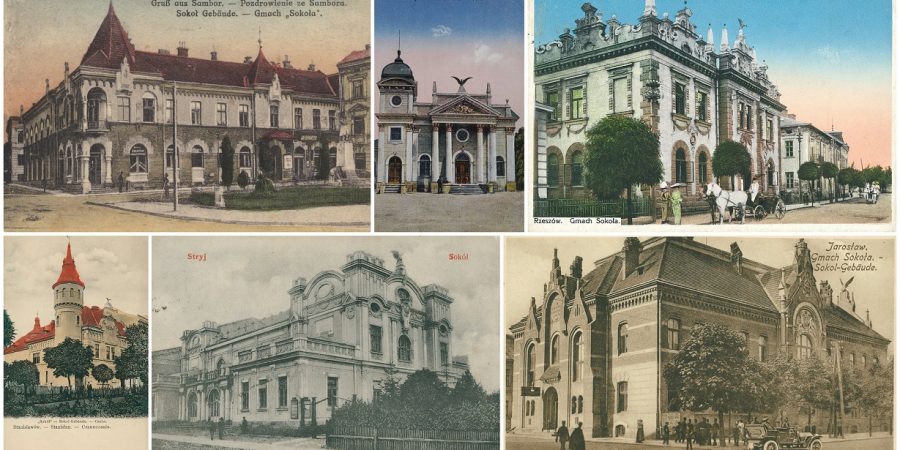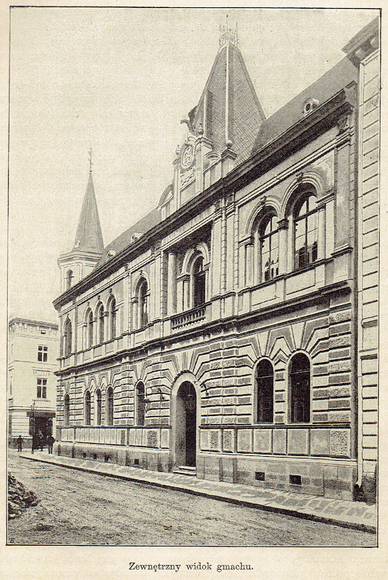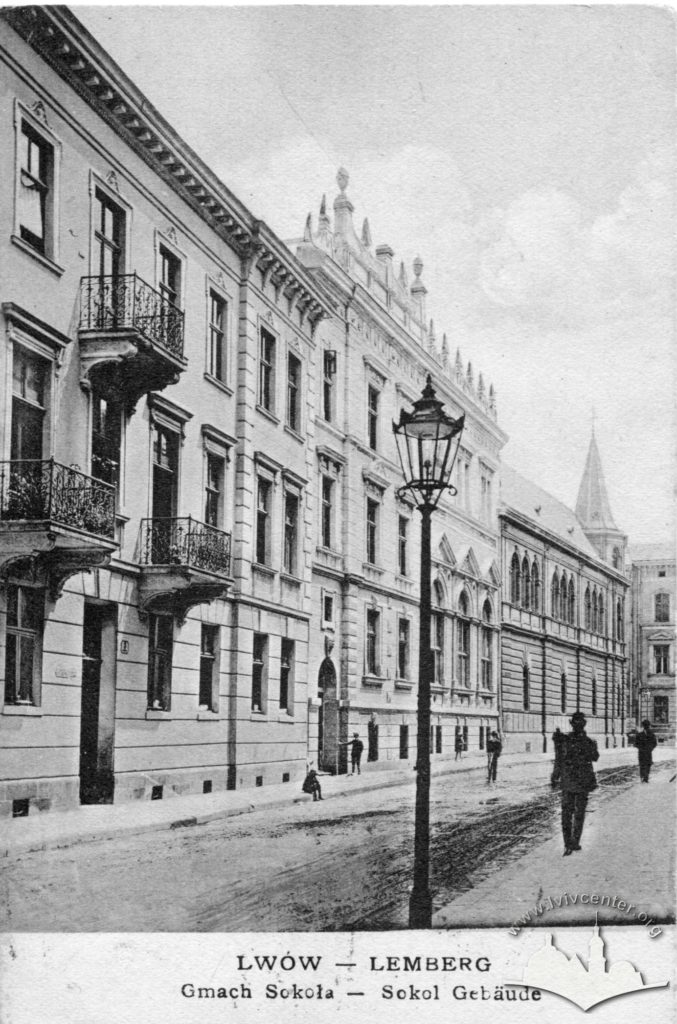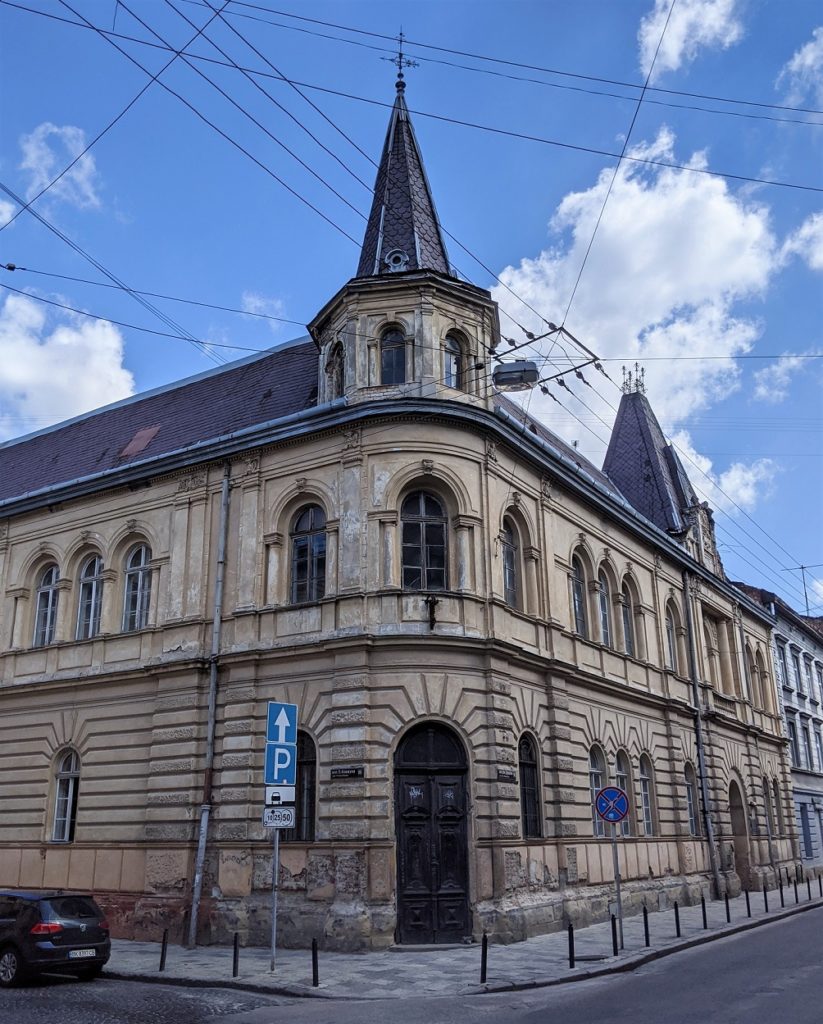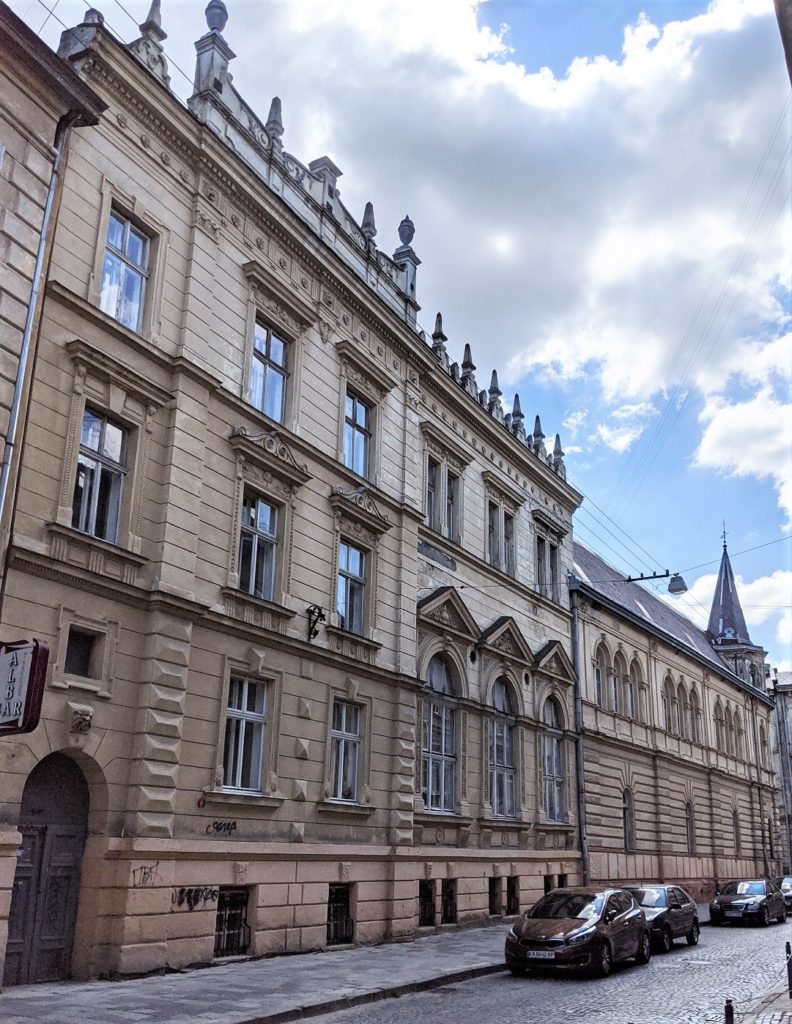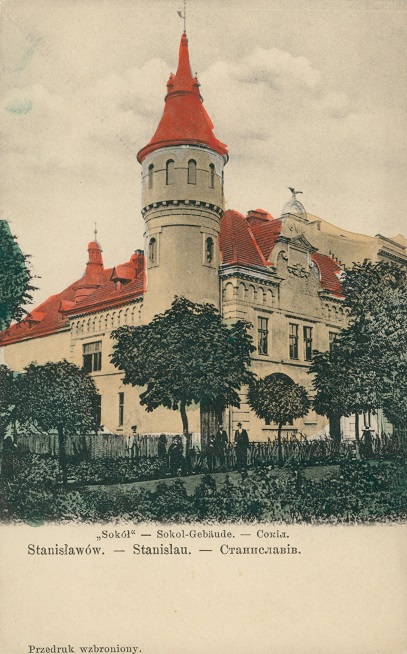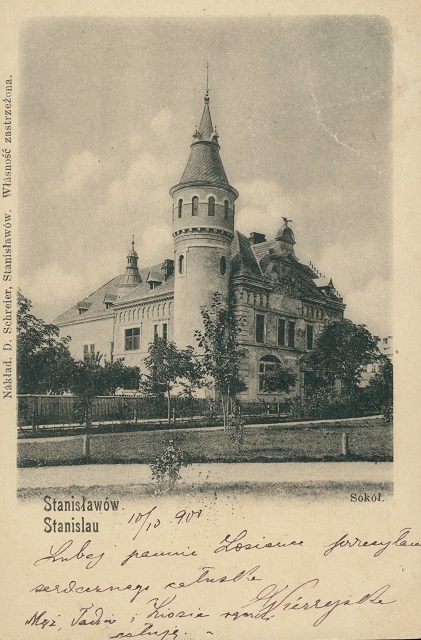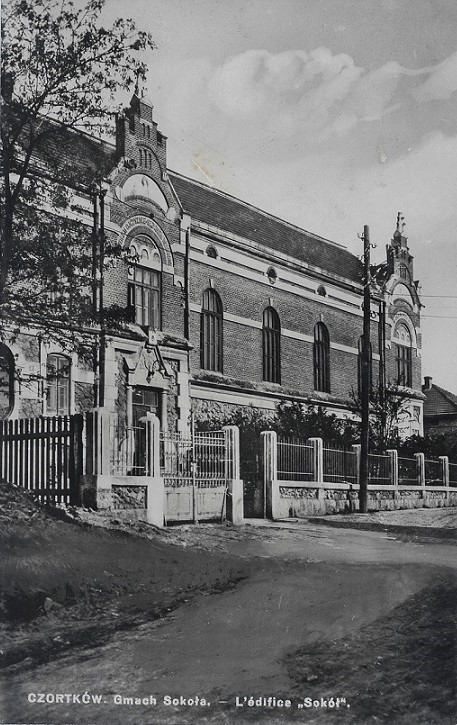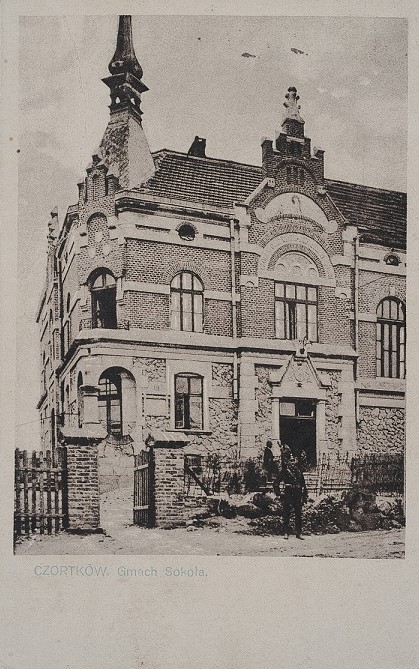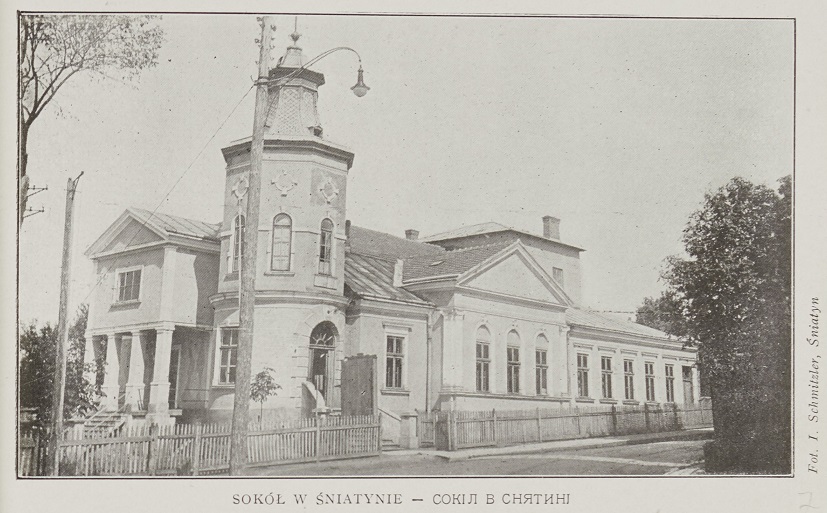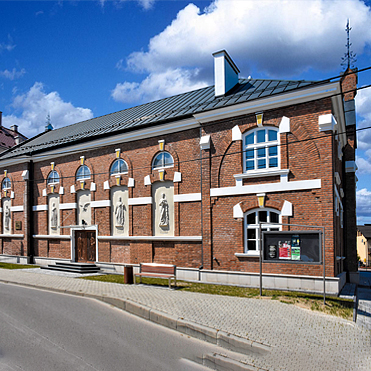The former buildings of the Sokół Polish Gymnastic Society stand today in the center of almost every Galician town on both sides of the Polish-Ukrainian border. Serving as sports and cultural centers, these were once significant buildings in the town space and often outstanding architectural masterpieces.
Although today few of the buildings still belong to the Sokół society, many remain cultural or sports centers as well as important historical and architectural objects.
The Sokół Society: A Brief History
The Sokół (Falcon) Polish Gymnastic Society (Polish: Polskie Towarzystwo Gimnastyczne “Sokół”) was established on February 7, 1867, in Lwów (Lviv), when the city was the capital of the Austrian crownland of Galicia. Founders Klemens Żukotyńcki and Ludwyk Goltenthal modeled the society on a similar Czech organization Sokol.
The basic aims of the society were the promotion of gymnastics and national revival in all parts of partitioned Poland. The group’s goal was to develop fitness, both physically and mentally, with a motto mens sana in corpore sano (“a fit spirit in a fit body”).
Sokół promoted physical fitness, in particular by running a program of lectures and self-education courses. It also organized celebrations commemorating important events throughout Polish history.
The Sokół society (the first nest in Lwów was later referred to as Sokół-Macierz, “the Mother Falcon”) existed for some time only in Lwów, and then in 1884 began to spread throughout Galicia. That year, the next units, called gniazda (nests), were formed in Stanisławów (Ivano-Frankivsk) and Tarnów, and the following year in Kraków, Kolomyja (Kolomyia), Tarnopol (Ternopil), and Przemyśl.
Eventually the movement spread outside of Galicia and by the end of World War I, Sokół had nests in all parts of Poland, as well as in Polish communities abroad.
Sokół activities were banned during the Nazi occupation of WWII, and remained outlawed throughout the Soviet era until the organization was revived in 1988. Today there are about 80 Sokół nests across Poland.
Sokół should not be confused with the Ukrainian Sokil (Сокіл) organization, which also appeared in Lwów (Lviv) albeit 17 years later, and which from 1909 was called “Sokil-Batko” (Falcon-Father).
Sokolnie: Sokół’s Architectural Heritage
To gather for training and to hold various events, Sokół needed a physical space. In Lwów, the society first rented rooms in various institutions around the city until it built its own building in 1884.
In other towns around Galicia, the nests of Sokół first used gyms at local schools or other rented-out spaces. Only around the turn of the century did they start to build their own buildings. They raised funds by organizing various events such as festivities, balls, or lotteries.
The so-called sokolnie (singular: sokolnia) began to appear in the cultural and urban landscape of Galicia. These buildings were predominantly masonry constructions of high architectural significance, often designed by renowned architects. Besides the town hall and the parish church, they quickly became one of the most important buildings in town.
In addition to serving as a space for physical training, the sokolnie served as cultural centers. The architectural expression of these objects was closely connected to their purpose. The buildings were to be simultaneously sports centers and headquarters of the society where its members could meet. According to architectonic handbooks from the second half of the twentieth century, a Sokół building should have an imposing staircase with a vestibule, a spacious meeting room, a library, a reading room, a management office, an archive, and of course a gym.1
The most common styles used for these buildings were Historicism, Secession, and Neoclassicism. They were typically crowned with a sculpture of a falcon or an eagle.
Another interesting fact about these buildings is that many of them ended up housing the town’s first cinema.
***
Such culturally and architecturally significant buildings, the sokolnie were featured on postcards of the time. Thanks to these images, it is possible to see how they looked originally. Below I’ve gathered many examples together with images of how they look today. (This is not a complete collection.)
Eastern Galicia (Now in Ukraine)
Lwów / Lviv
Nest formed: 1867
Sokolnia built: first building 1883-1884, second building 1906-07
Architects: Władysław Halicki, Alfred Kamienobrodzki
Style: Historicism, Neo-Renaissance
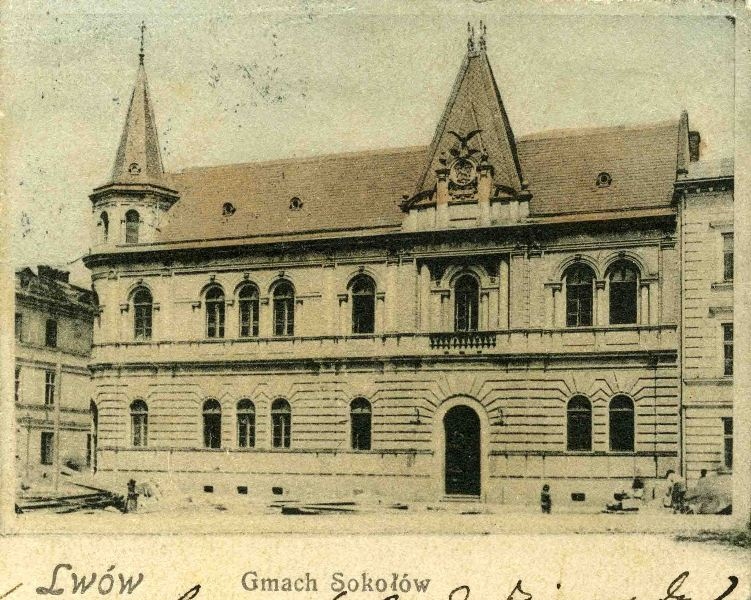
Having no home of its own, Sokół first used a room at 11 Jagiellonska St. (now Hnatiuka St.), from 1867-77 the Höcht’s Casino, and then rented a room at the Kurkowe Riflemen Society. Finally, with the assistance of the long-term chairman of the society (1871-1886) Jan Dobrzański, Sokół received its own building on Zimorowicza St. (now Dudayeva St.). The building was designed by architect Władysław Halicki, and in the autumn of 1883 architect Alfred Kamienobrodzki began its implementation. On December 2, 1884, the sokolnia hosted the first gymnastic competitions. The headquarters of the Lwów Sokół were located in this building until 1919. In 1913–1939, the Sokół-Materi Cinema operated in the building. All profits from his activities went to the needs of Sokół.
In 1906, due to a need for more room, Alfred Kamenobrodski designed a new neo-Renaissiance building with a Polish-style Mannerist attic with volutes attached to the existing one. The society was housed in these premises until 1939.
Today both buildings are used by the Lviv Institute of Physical Culture.

Sokół logo and motto: Mens sana in corpore sano (“a fit spirit in a fit body”)
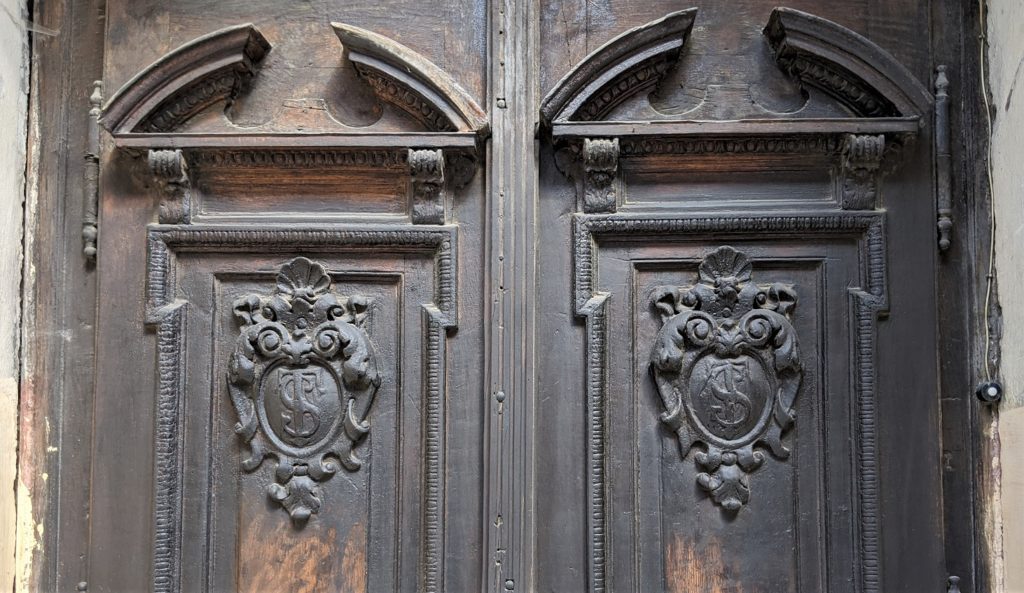
Stanisławów / Ivano-Frankivsk
Nest formed: 1884
Sokolnia built: 1895, with further work in 1905, reconstructed in 1929
Architects: Jan Kudelski, Karol Zaremba
Style: Historicism with neo-Gothic, neo-Renaissance, and neo-Baroque elements
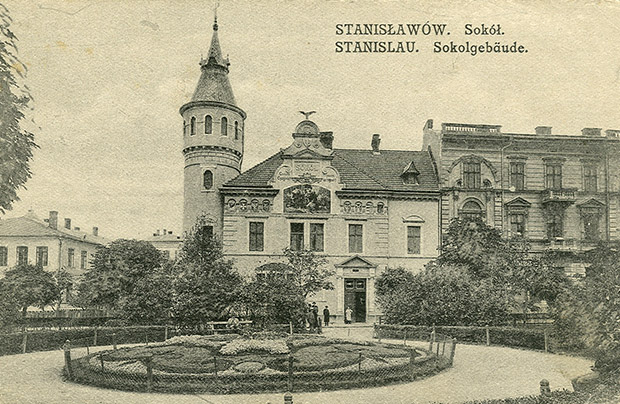
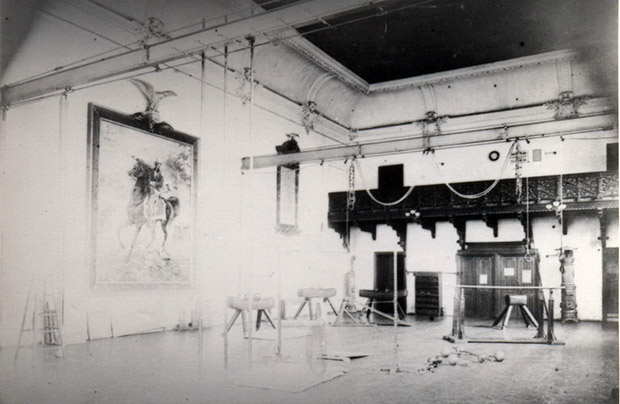
Some sources name Jan Kudelski, others Karol Zaremba as the architect. It is likely they both contributed. The two-story brick and plaster building is in the style of Historicism. The three-tiered decorative pediment was crowned with a sculptural image of a Polish eagle (not preserved). In the decoration of the building, neo-Gothic (arch, tower with a room), neo-Renaissance (high roof) and neo-baroque elements were used.
The building was reconstructed in 1929, and in the rear the Ton Cinema was built. Since 1945 the building has housed a regional children’s library.

Kolomyja / Kolomyia
Nest formed: 1885
Sokolnia built: 1895
Architect: Ivan Levynskyi
Artist: Walerian Kryciński
Style: Zakopane Style
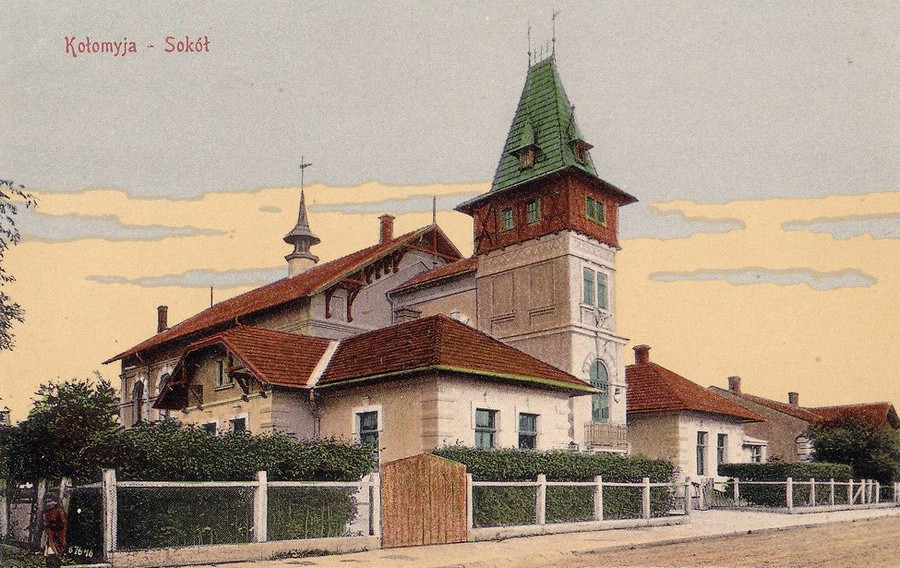
In addition to housing the local Sokół branch, a bicycle department with 23 members met on the premises of the Kolomyja sokolnia. During World War ІІ, in 1915, the Second Legionary Brigade was formed in Kolomyja under the name Żelazną, which included many members of the Sokół. From December 1918 to May 1919, the UHA (Ukrainian Galician Army) officers’ school was located in the building, but after the capture of Ukraine by Polish troops, Sokół returned to the building. The Polish Sokół Society existed until 1939 when Western Ukraine was captured by Soviet troops.
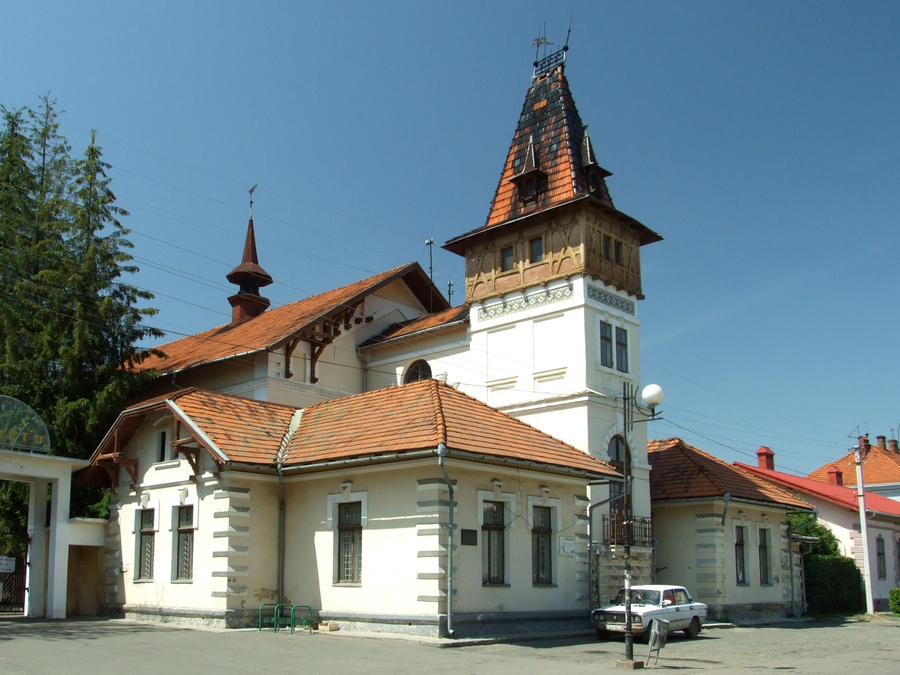
Żółkiew / Zhovkva
Sokolnia built: Turn of the 20th century
Style: Neoclassical
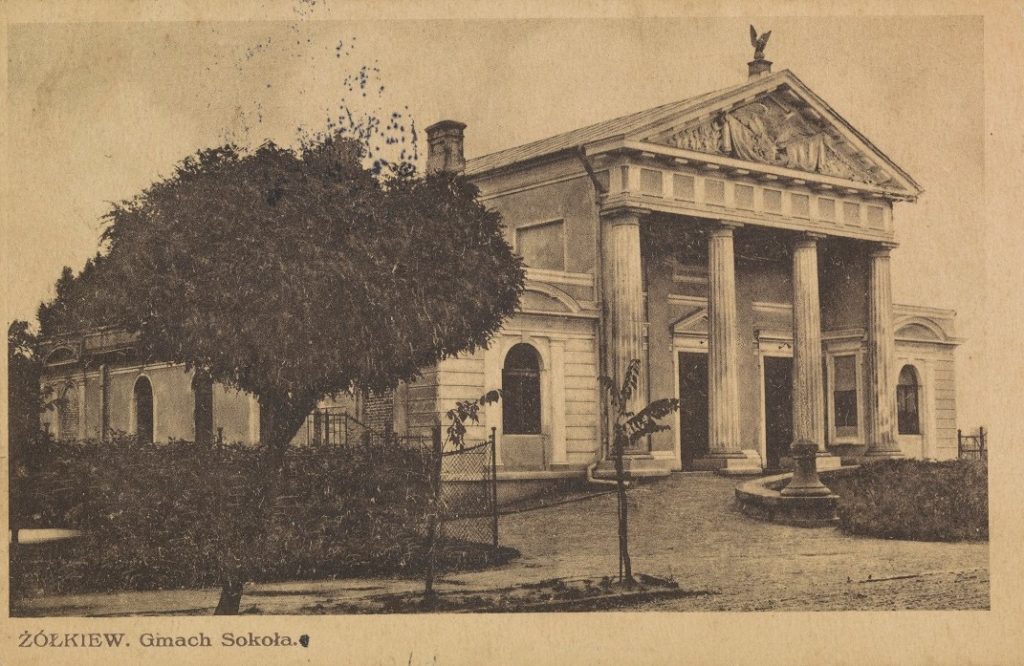
After the war, the building was used as a garrison club of the Soviet army. Since 1996, the building has been owned by the district council. The building’s facade is decorated with a portico and four Doric columns.
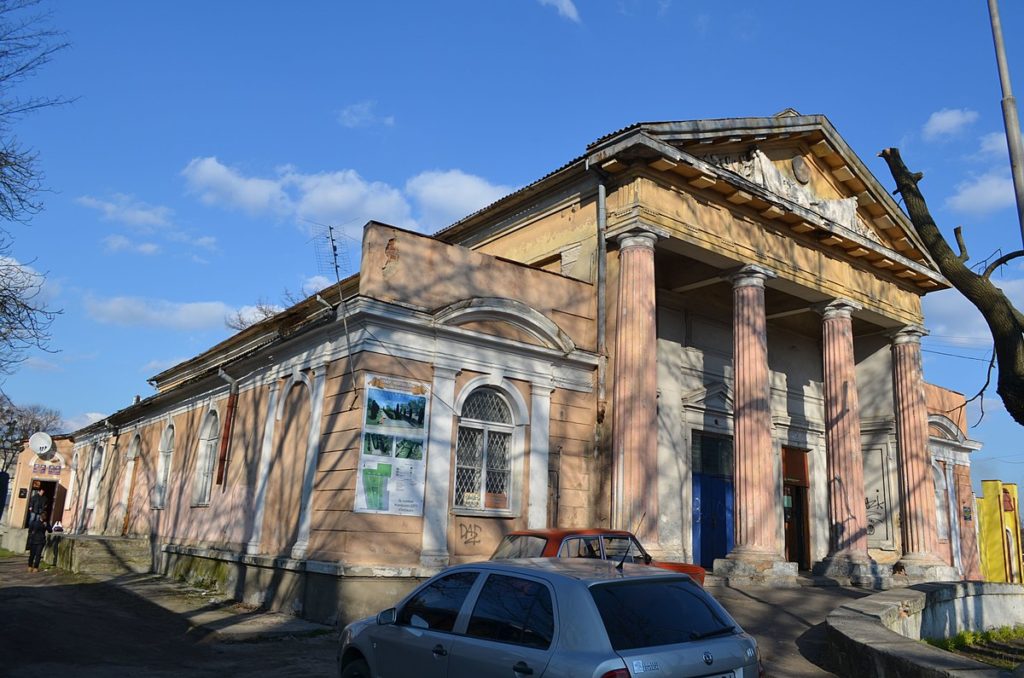
Brody
Nest formed: 1891
Sokolnia built: 1909-12
Architects: Wawrzyniec Dayczak and Jerzy Grodyński
Style: Neo-Romanesque
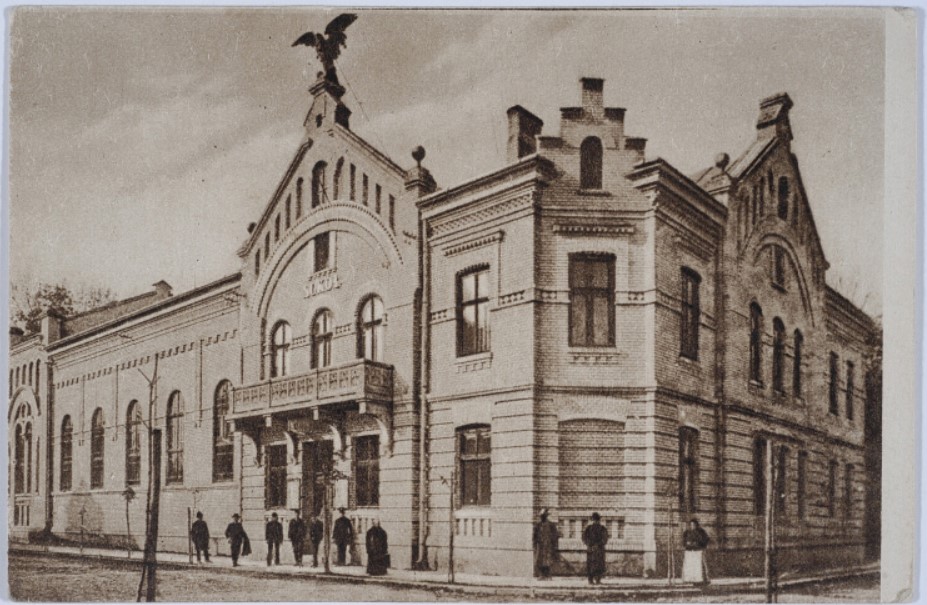
At first, the society did not have its own building and so it used the premises of the Gwiazda Society of Christian Craftsmen.
The official opening of the building was in 1912. Beginning that year, the city’s first cinema began operating in the sokolnia. There was a library in the building, founded by the famous Brody bookseller and publisher Felix West. On the south side of the building there was a small summer playground, where a skating rink was made in winter. A tennis court was set up in the western part of the courtyard during the interwar period.
The pediment of the main facade of the building was topped by a sculpture of a woman-bird with large wings (Falcon-Mother), which was dismantled during the first Bolshevik occupation (1939-1941). An interesting element of the building is the balcony overlooking the gymnasium square, from which in the past various dignitaries addressed the city residents.
During the years of German occupation (1941-1944) there was a cinema for Germans. After the war, the building was transferred to the district house of culture.
Today it is the premises of the Brody district National Home.

Sambor / Sambir
Sokolnia built: 1904
Style: Historicism
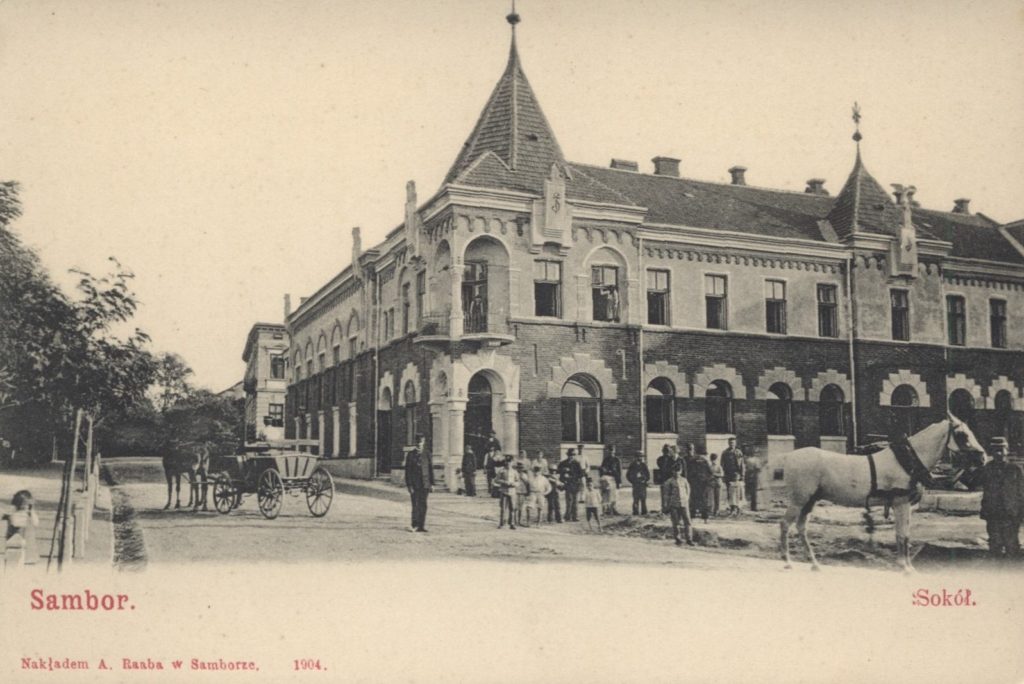
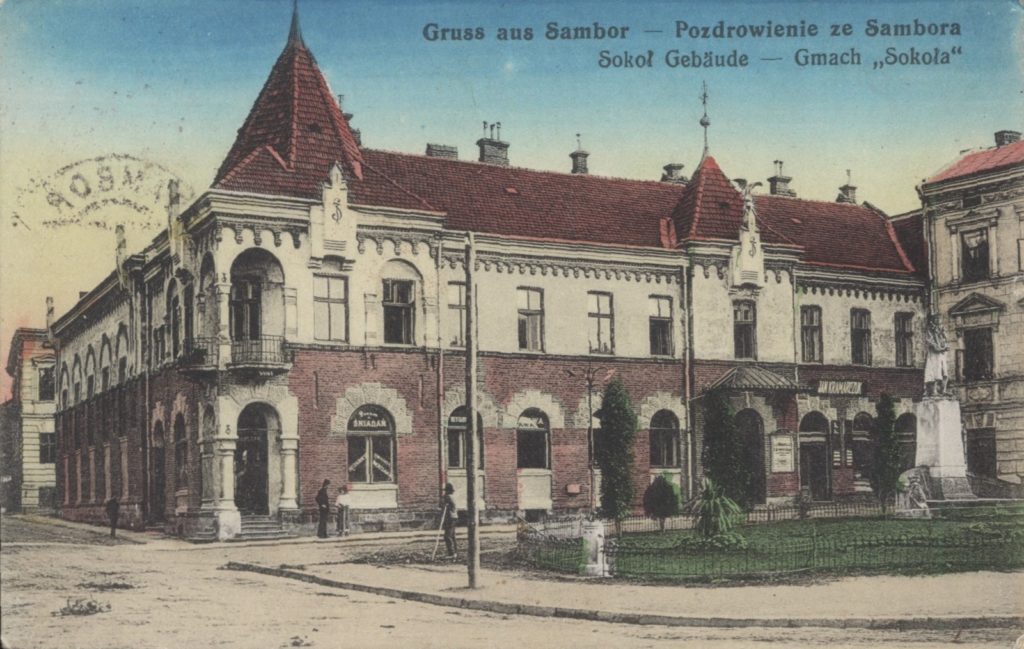
Most of the architectural details are gone. Today it is the Narodnyi Dim (People’s Home).
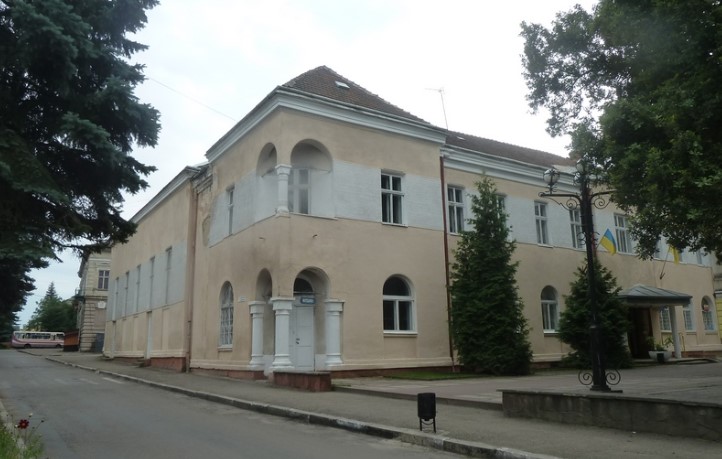
Kalusz / Kalush
Sokolnia built: early 20th century
Style: Late Secession with elements of neoclassicism
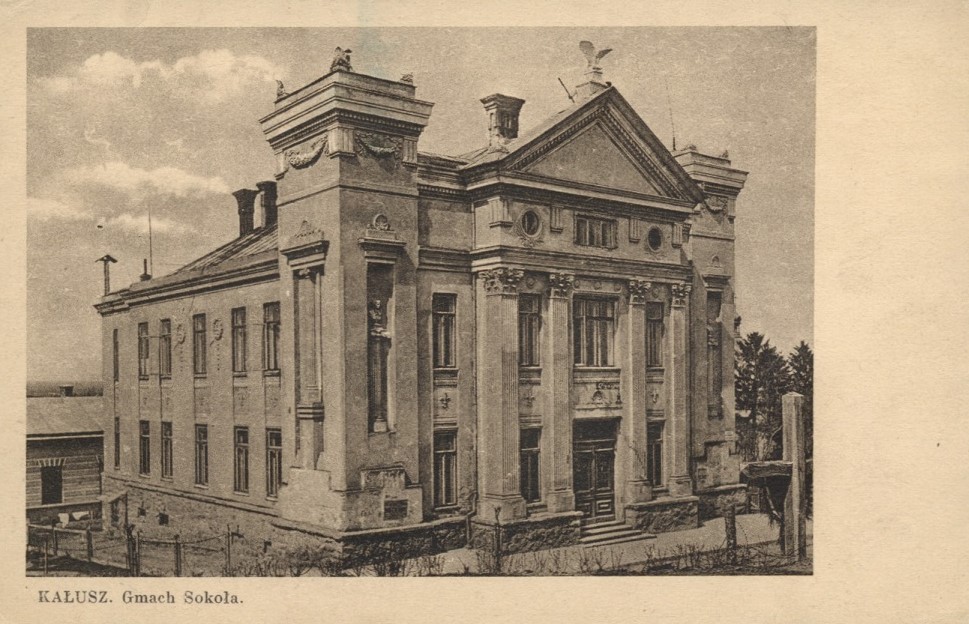
Today it is a concert hall.
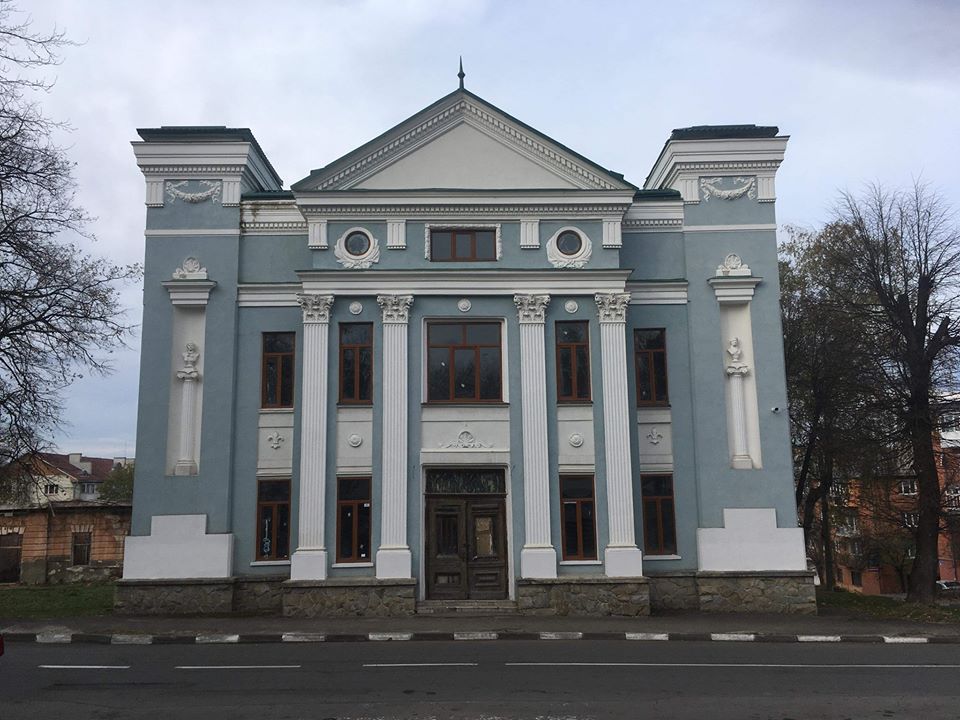
Czortków / Chortkiv
Sokolnia built: 1908-1912
Style: Secession
The construction of the Sokół building was funding by local contributions of Poles and with the support of the then mayor of Czortków – Ludwik Noss. Today it is a cultural center.
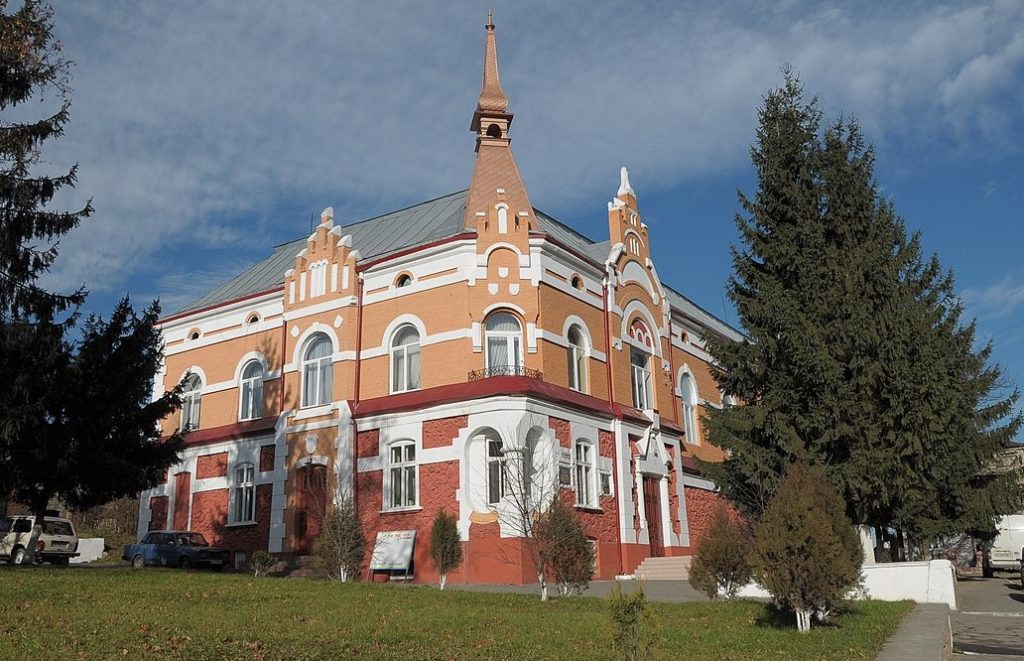
Stryj / Stryi
Local nest founded: 1892
Sokolnia built: 1906
Architect: W. Krzyżanowski
Style: Secession (Art Nouveau)
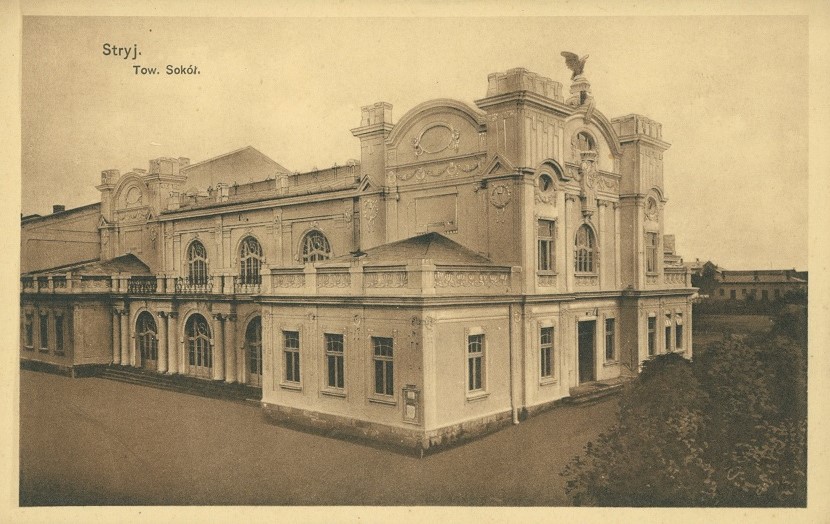
The Sokół nest in Stryi was formed in 1892 under the leadership of Michał Franciszek Słozarski and Gerus. In 1906 the construction of this building was completed, the architect of which was W. Krzyżanowski. The house is a bright example of Secession with a lush decor both inside and outside. In 1923, the structure was partially rebuilt. In the 1950s, the Stryi Drama Theater operated here. Now it is the city’s House of Culture.
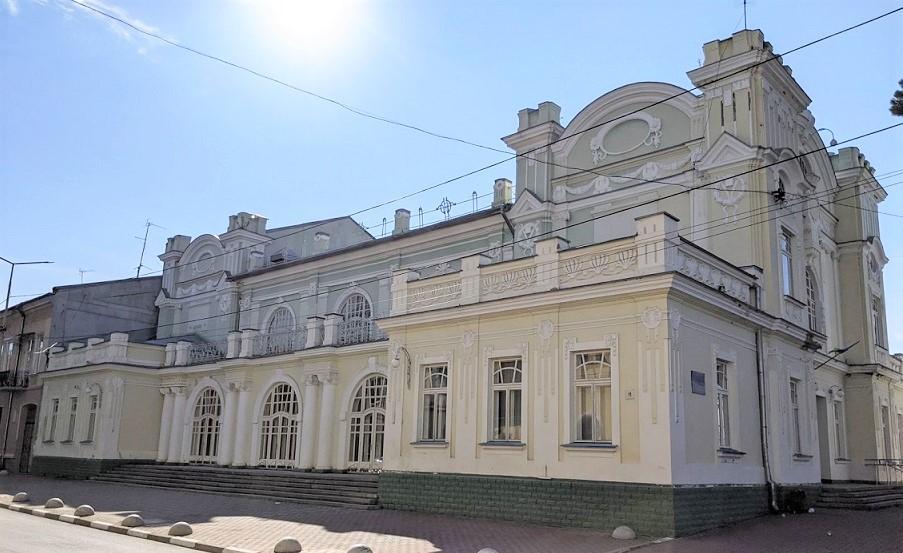
Drohobycz / Drohobych
Nest formed: 1890
Sokolnia built: 1893
Style: Historicism

During the Soviet Union, it was an Officers building. Currently, it houses a Ukrainian Greek Catholic youth center and a prosecutor’s office.
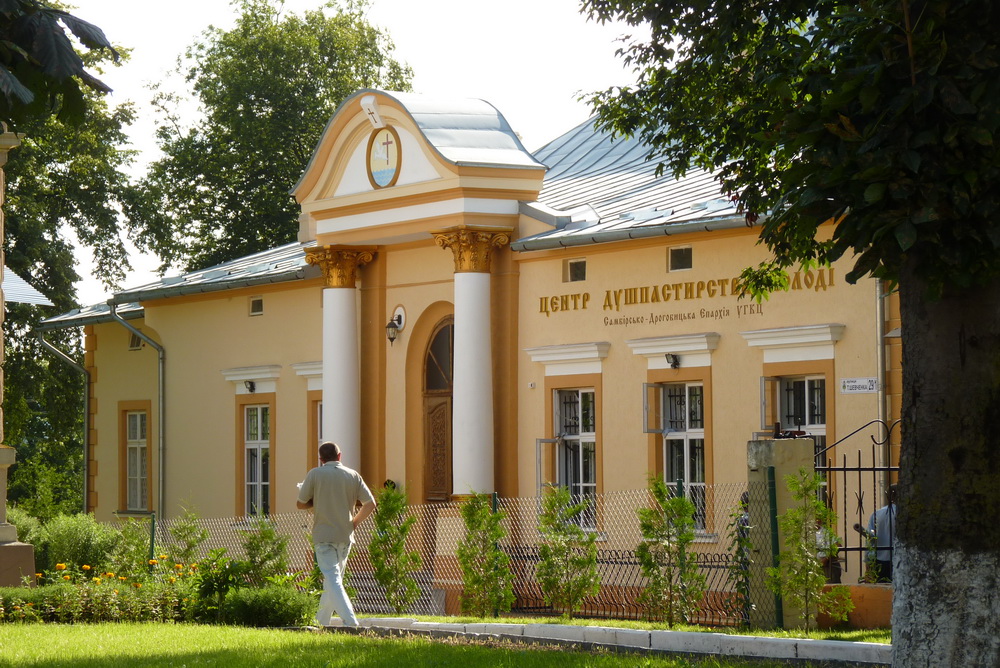
Brzeżany / Berezhany
Sokolnia built: 1903, expanded in 1910
Architects: designed by Szczęsny Barzykowski. Architect Władysław Hertman oversaw the technical side of the construction
Style: Historicism, Neoclassicisim
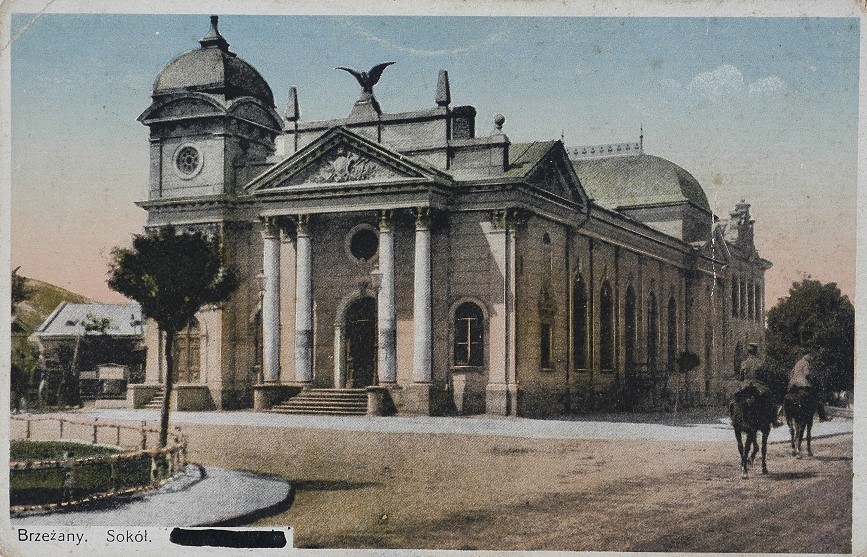
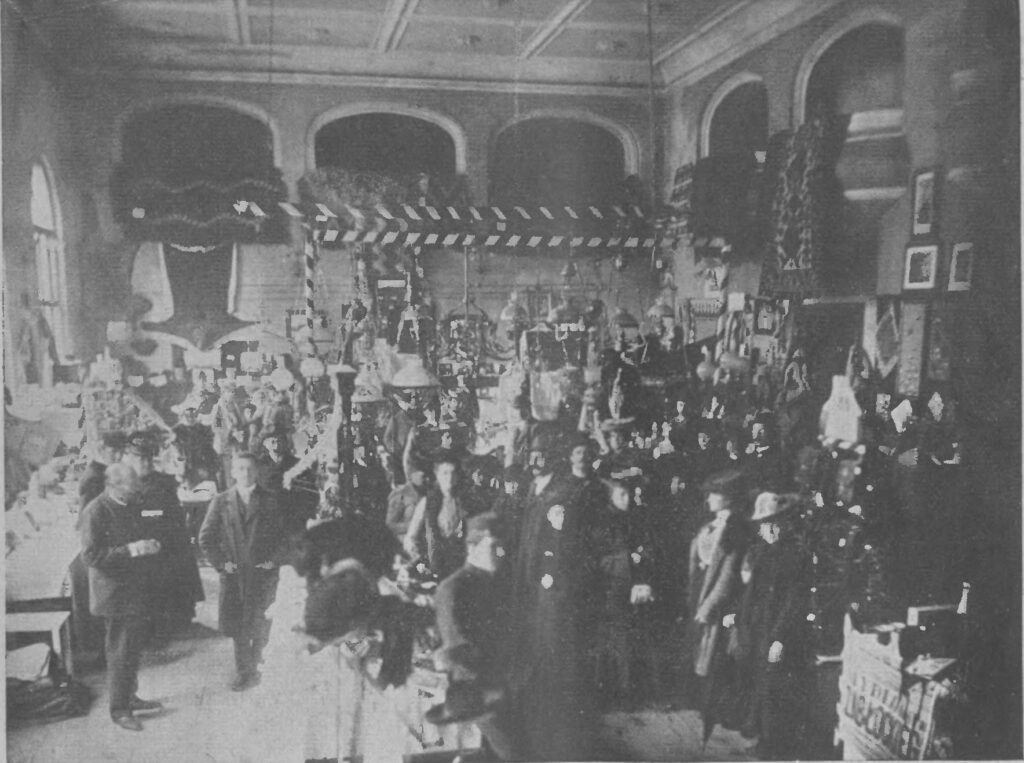
The Sokół building was used for various purposes — it was primarily a theater, library, cinema, a place for various business meetings and gatherings, the headquarters of local figures, as well as a place for parties, concerts, and celebrations, and more.
At the end of June 1941, several bombs were dropped on the building by a German bomber. The walls of the building survived but were not restored. The Soviet authorities decided to dismantle the building.
Today no traces remain of the Brzeżany sokolnia.
Trembowla / Terebovlia
Nest formed: 1892
Sokolnia built: 1905
Style: Historicism (Neo-Renaissance)
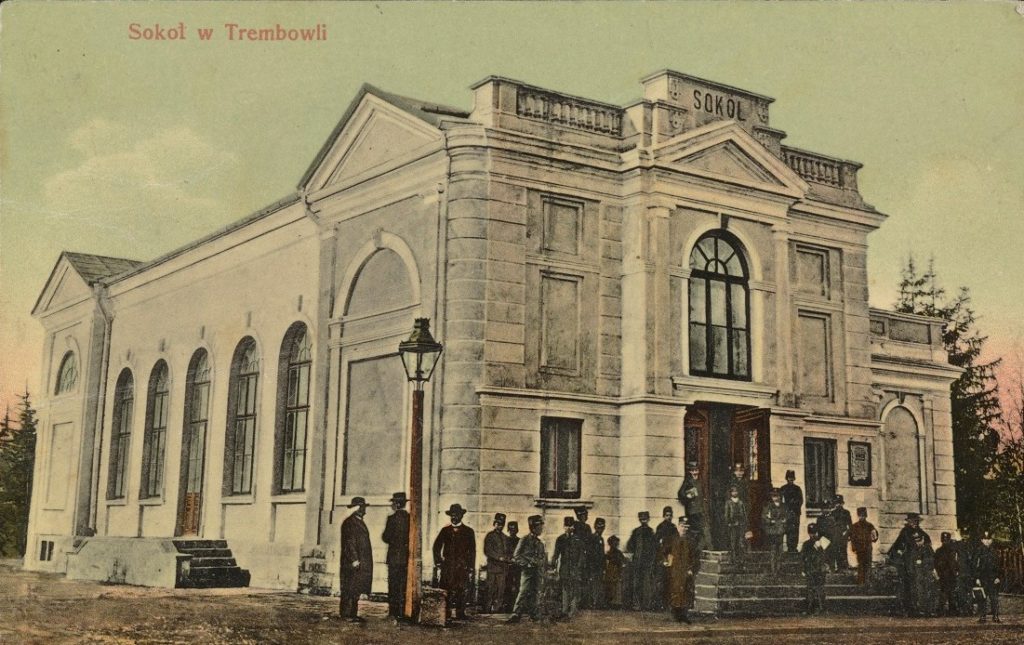
The grand opening of the Trembowla sokolnia took place on June 1, 1905. In addition to a gym, the structure had a library and rooms for concerts and theatrical evenings. During WWI, the Russian Army organized a church in the space. In the interwar period, it again housed a gym. Under Soviet rule (in the 1950s) there was a cinema, since 1964 the building has housed a children’s sports school.
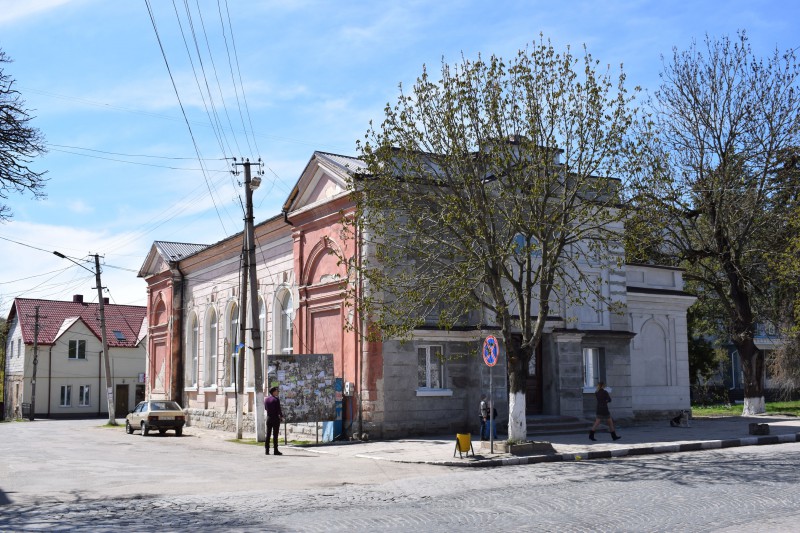
Śniatyn / Sniatyn
Sokolnia built Built at the end of the nineteenth century
Style: Historicism
A gym and other facilities suitable for creative and sports education have been preserved in the building. Today is houses a center for children’s creativity and the district station of young naturalists.
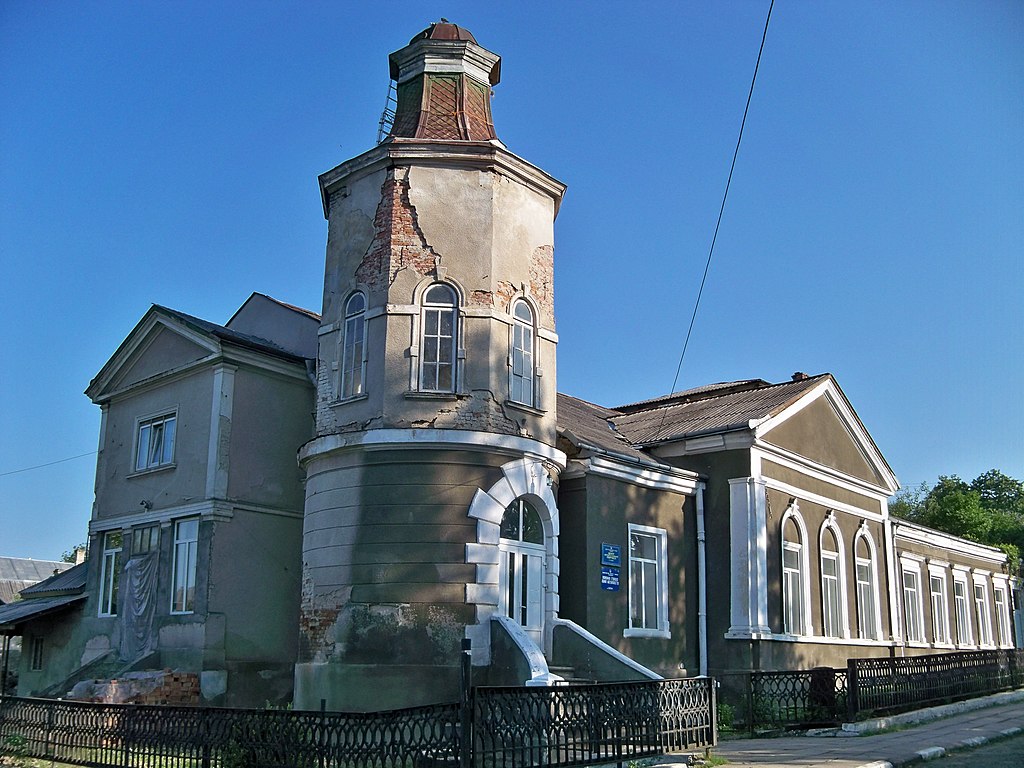
Western Galicia (Now in Poland)
Kraków / Krakow
Nest formed: 1885
Sokolnia built: 1889, enlarged in 1894
Architects: Karol Knaus, Teodor Talowski
Style: Historicism with neo-Gothic elements
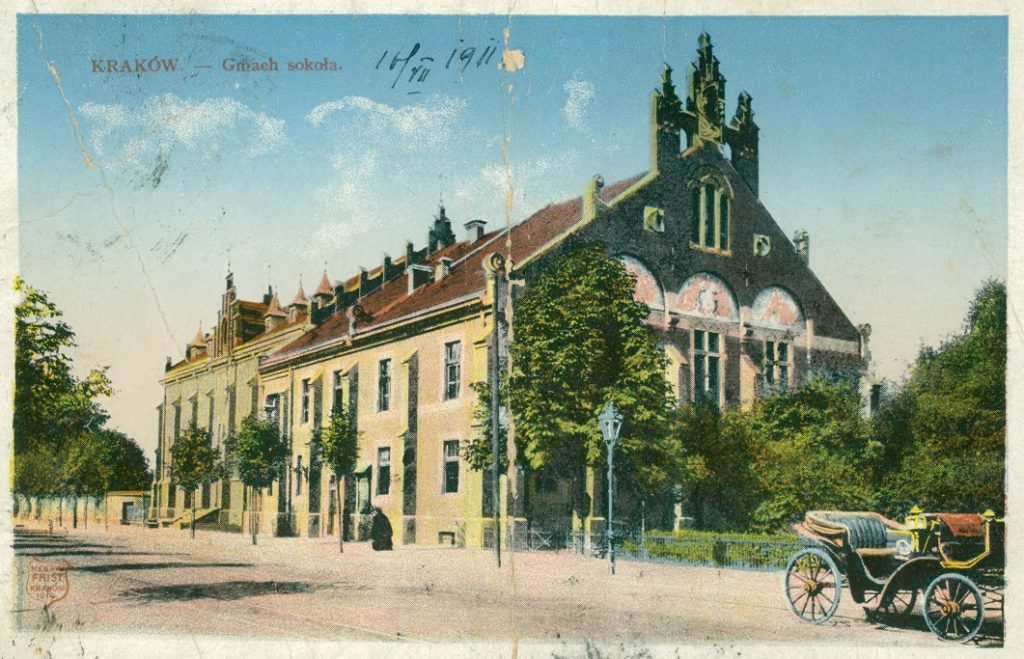
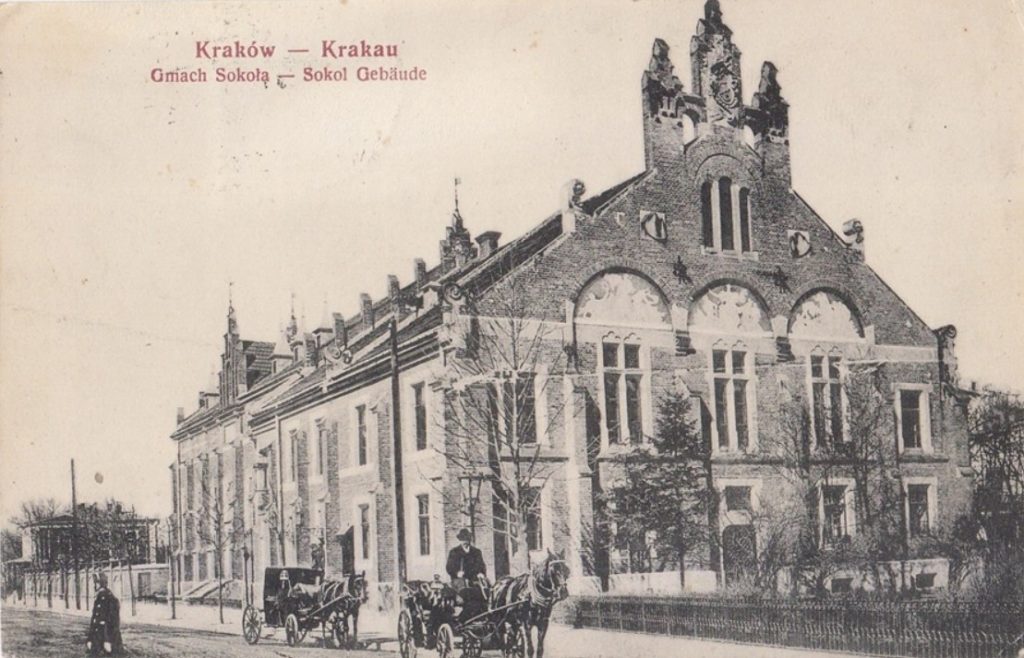
The Krakow Sokół headquarters was built in 1889 according to the design of Karol Knaus. In 1894, Teodor Talowski enlarged the building and decorated its facade with Romanesque and Gothic elements. Today it is a Sokół gymnastics club.
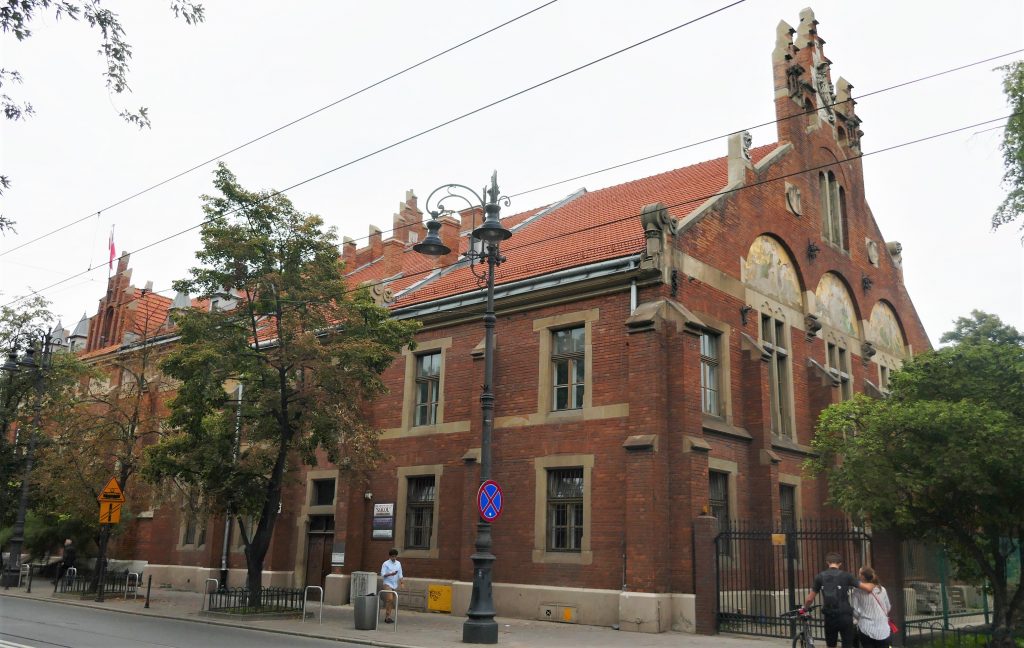

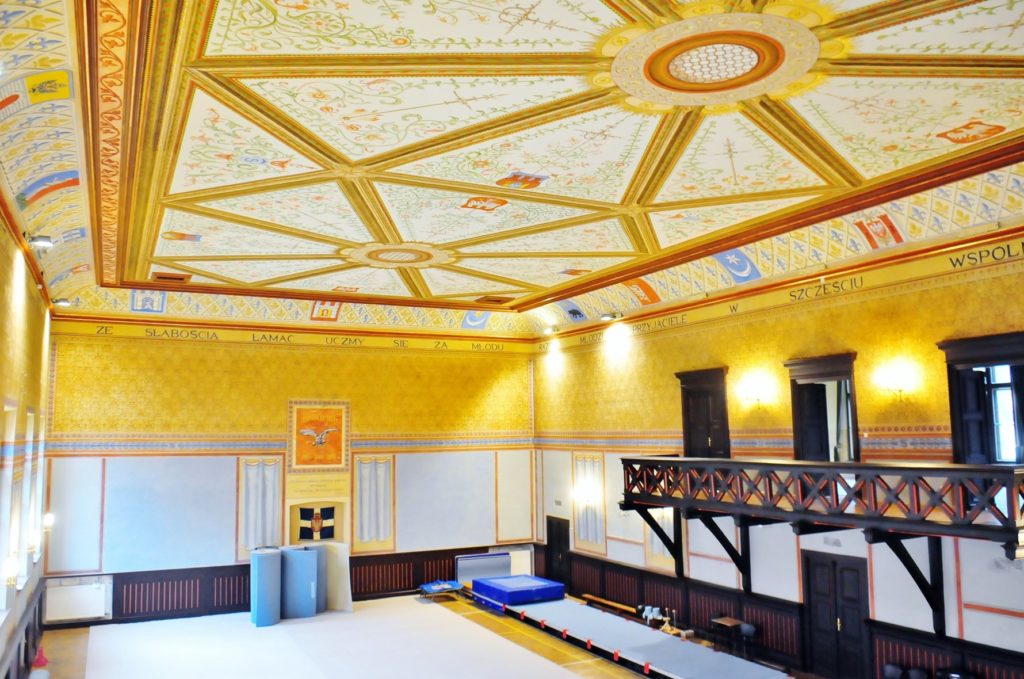
Wadowice
Nest formed: 1887
Sokolnia built: 1889
Architect: Teodor Talowski (of the reconstruction/expansion of the building)
Style: Historicism with neo-Gothic elements
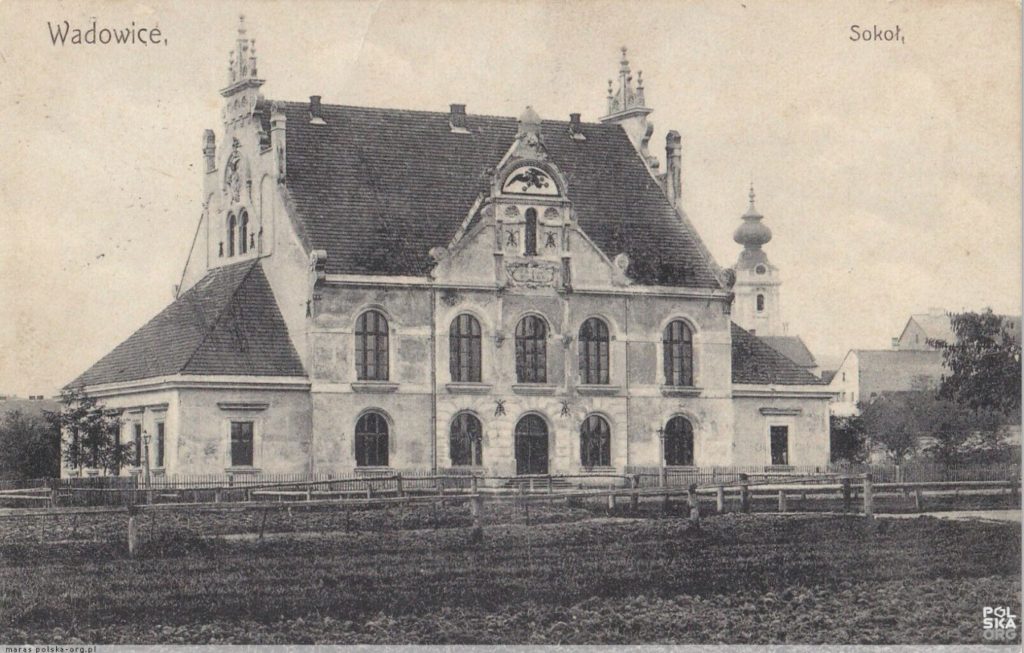
The sokolnia in Wadowice was a single-storied building covered with a gable roof with richly decorated gable walls. Inside, there was an exercise and theater room and numerous club rooms.
In the interwar period, the youth of Wadowice participated in sports activities in great numbers. In the Sokół building, patriotic ceremonies were organized. The plays by Greek classics were performed on stage there.
In the 1950, the upper part of the building was destroyed and rebuilt, giving it its present-day shape. Currently, the building houses the Wadowice Cultural Center.

Jarosław
Nest formed: 1889-1947
Sokolnia built: 1899-1900
Architect: Teodor Talowski
Style: Art Nouveau, neo-Gothic, neo-Romantic
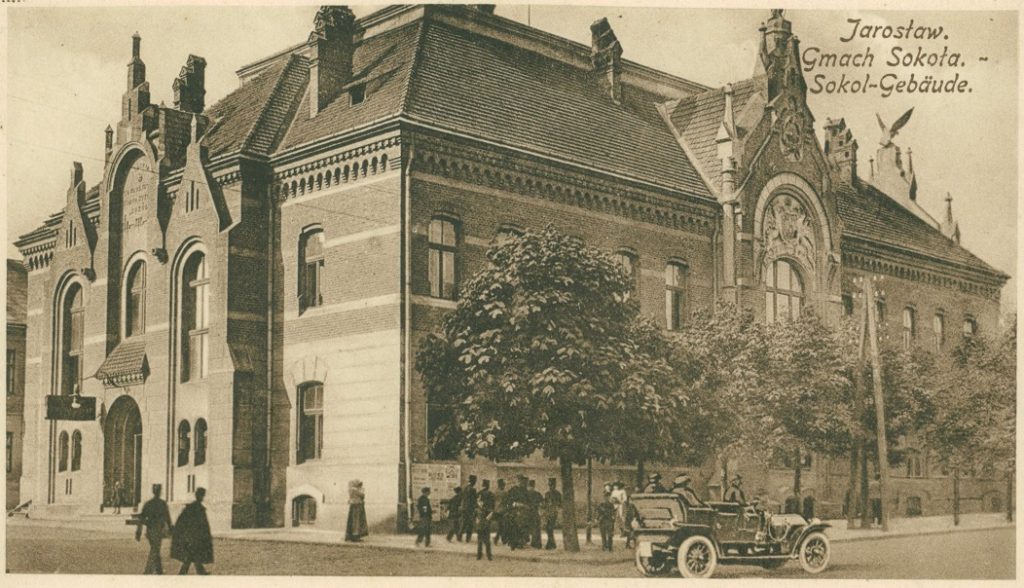
Jarosław’s Sokół housed a cinema-theater hall with balconies and a gallery in the rear part, rooms for activities and meetings on the first floor as well as an open terrace for gymnastic exercises. From the north side the top of the façade is surmounted by a sculpture of a winged young man — a personification of the sport, while from the west by a sculpture of a falcon. The building façades were decorated with reliefs showing: the coat of arms of Jarosław supported by two griffins, the coat of arms Pogoń — the old coat of arms of Lithuania, and an eagle with a crown on the background of a wreath of bay leaves. (Patriotic symbols in the Austrian Partition could be freely placed on public buildings, because Galicia’s autonomy allowed it.)
After World War II, the building was the headquarters of the Jarosław District Cultural Center, the Gdynia cinema. Today it houses the Municipal Culture Center.

Rzeszów
Sokolnia built: 1892
Architect: Albin Zagórski
Facade decoration: Franciszek Skowron
Style: Polish neo-Renaissance
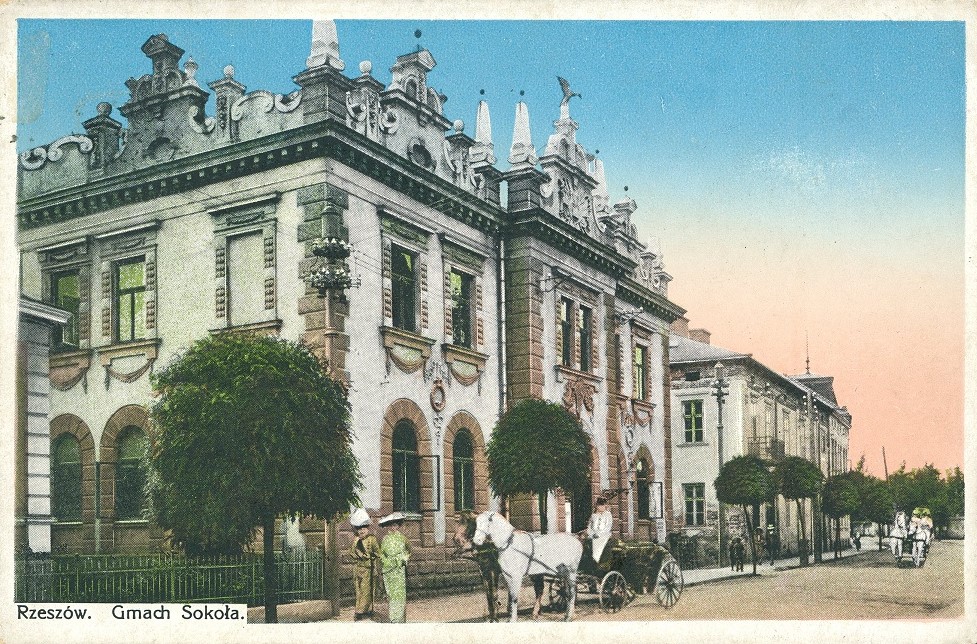
Architect Albin Zagórski designed the building (free of charge), while Franciszek Skowron designed the facade. It had a rich attic (balustrade covering the roof), and above the entrance a cartouche was crowned with a figure of a stone eagle.
The building housed a show room, meetings and trainings, a gym, as well as offices and warehouses. There was a training ground next to the building. An ice rink was organized on the pond in winter.
The Sokół building was an informal cultural center of Rzeszów. Theaters of Lviv and Kraków, as well as amateur groups, performed on the stage. Rzeszów residents met at concerts and games. There was also a permanent music band Meluzyna. In 1935 central heating was installed in the building. At that time, the stage was extended and a balcony was added, but the boxes were closed.
During World War II, a clinic for German soldiers was located in the building. In October 1944, the building was occupied by the National Theater. In the 1950s, the façade was destroyed — it was not rebuilt until it was renovated in 2004. In 1957, the building was connected to the neighboring house.
Today it houses the Wanda Siemaszkowa Theater.

Nowy Sącz
Sokolnia built: 1892
Style: Historicism (Neo-Renaissance and Neo-Baroque)
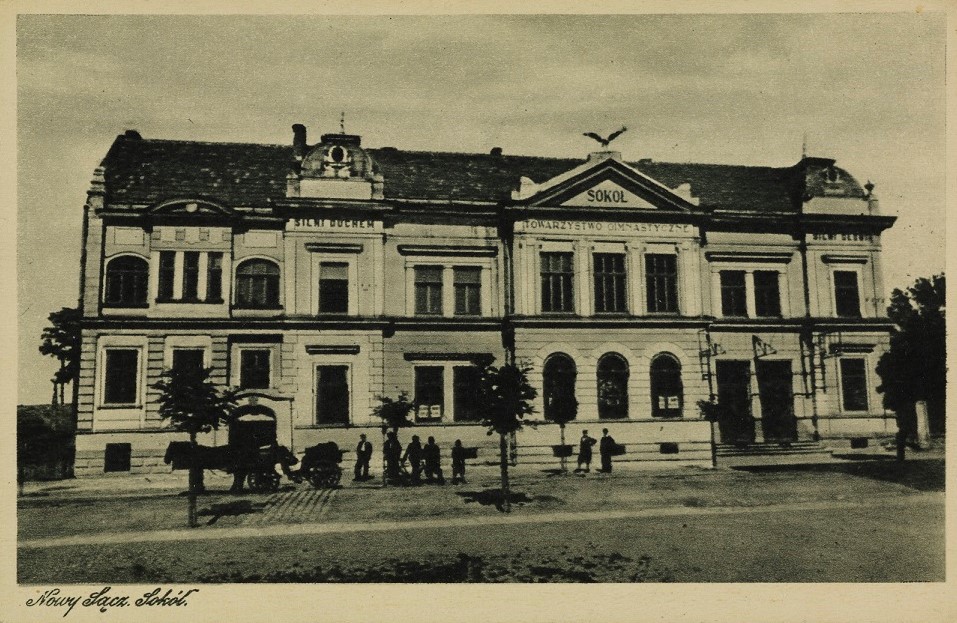
Sokół’s building in Nowy Sącz was built in 1892, and enlarged in the following decades, becoming the most important regional cultural center. After World War II, the building stood neglected. In 1993, the city authorities offered it to the Małopolska Region Cultural Center (MCK), which undertook a ten-year-long renovation of the historic building and its enlargement for the needs of a contemporary art gallery.
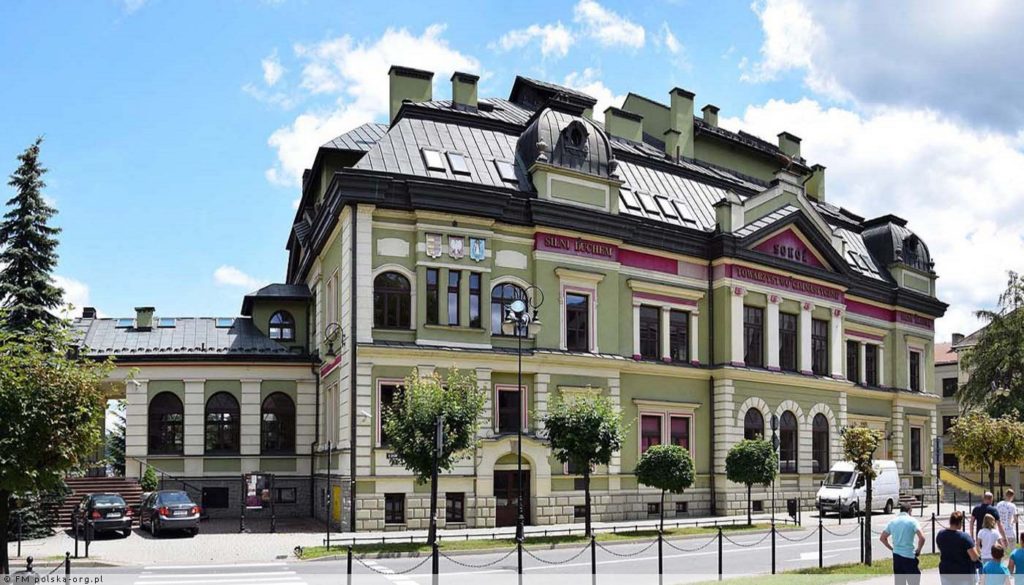
Stary Sącz
Sokolnia built: 1907
Architect: Zenon Adam Remi
Style: Historicism with elements of Secession
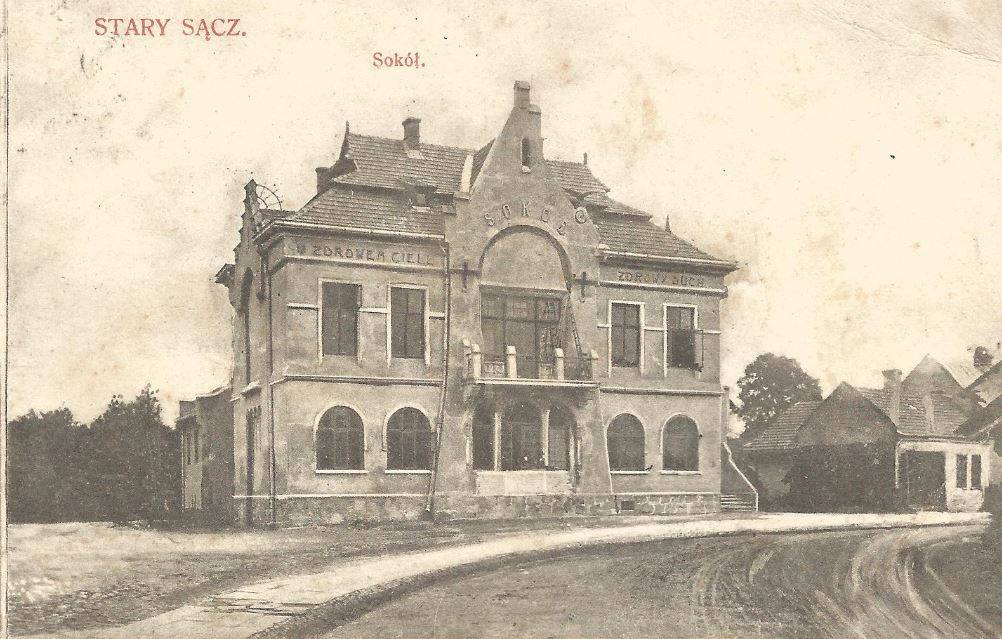
After World War I, the town’s first cinematograph was installed here. Before each screening, a gasoline-powered generator was set up in Sokół’s courtyard. The screenings were often interrupted because either the set broke down or the film stuck.

Nisko
Nest formed: 1903
Sokolnia built: 1904
Style: Historicism (Neo-Romanesque, Picturesque), Secession
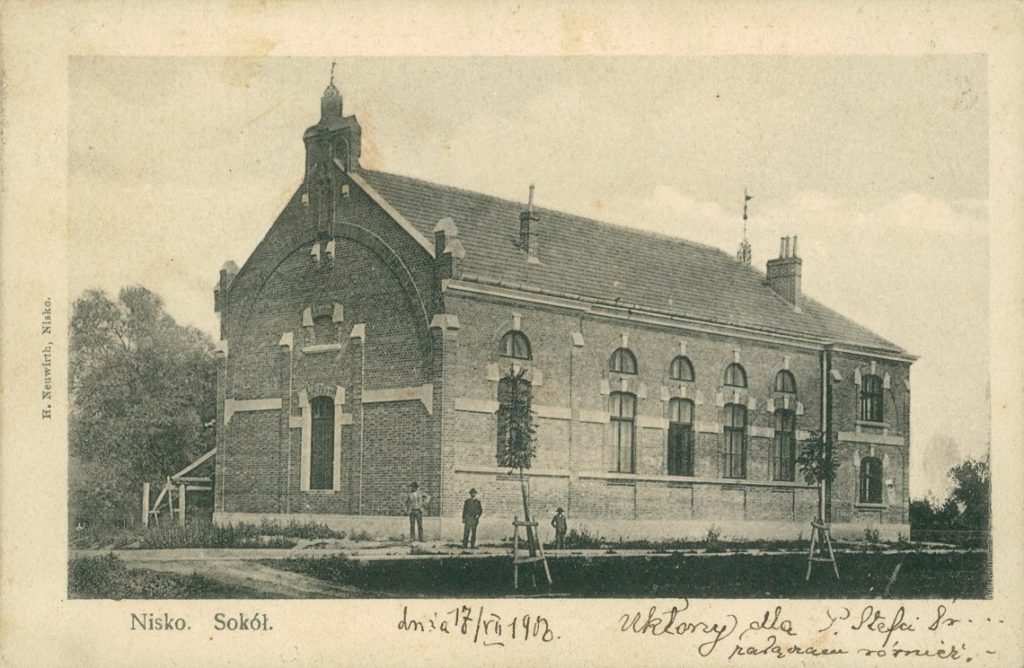
In the club’s monograph, Mariusz Kowalik describes the building as follows:
It was built in the Art Nouveau style, characteristic of the Sokół buildings in Galicia. It was built with social contributions of the inhabitants of Nisko, financial help from the local board and thanks to the support of counts Olivier and Maria Resseguier.
The building had various functions, mainly serving as a sports hall, but the area within its walls was also developed into a community center, cinema, or club. There were sports events, meetings, conferences and meetings of the public with the authorities. In 1908 the first film projection in the area took place there. There was no shortage of events such as numerous balls and games.
After the Nisko church burned down during World War I, the large Sokół hall was used as a chapel, holding services until 1923.
Today it is a cultural center. A few years ago it was expanded and modernized.
Brzozów
Sokolnia built: 1910
Architect: Jan Sas Zubrzycki
Style: Historicism (Neo-Romanesque)
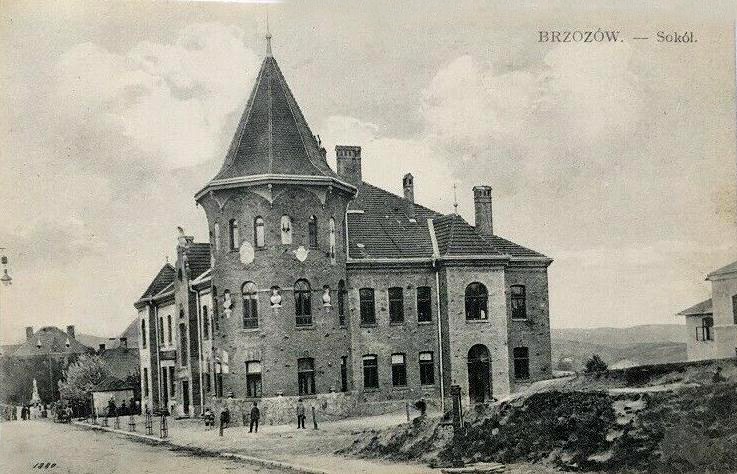
The efforts aimed at the construction of a local sokolnia began around the year 1905. In 1906, the community council provided the society with a plot of land, while the diocese donated the timber to be used for the building’s construction. The building was erected in 1910.
Brzozów’s sokolnia was designed by renowned architect Jan Sas Zubrzycki. The architect responsible for the construction process was Stanisław Majerski, whose workshop in Przemyśl also created the sculptural decorations on the building’s facade, which incorporated patriotic themes and included the coat of arms of Galicia and Lodomeria, of Brzozów, and of the Commonwealth of Three Nations.
The building suffered extensive damage during both world wars and was reconstructed on both occasions. In 1954, the building was refurbished and adapted for use as a District Community Center. In 1972-1976 the auditorium was converted into a movie theater.
Today it is the Brzozów House of Culture.

Tuchów
Nest formed: 1898
Sokolnia built: 1911
Style: Historicism (Neo-Romanesque)
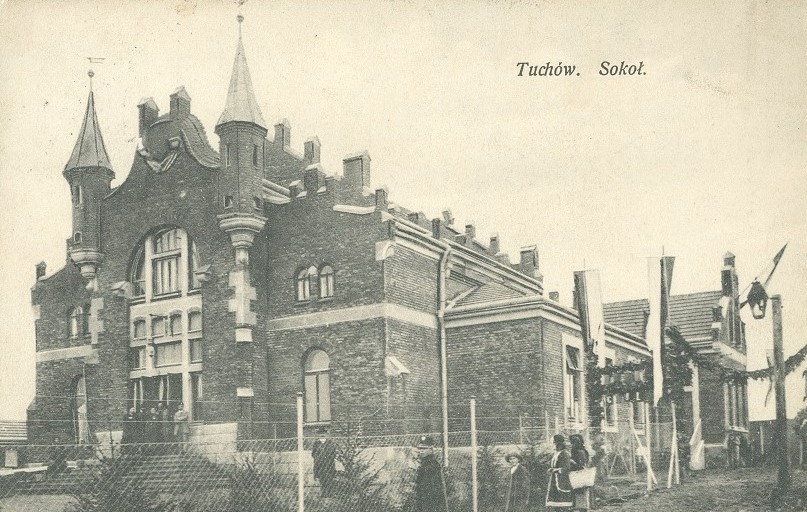
In 2018 the sokolnia underwent major renovation. Today it houses the non-local department of the Tarnów District Court.
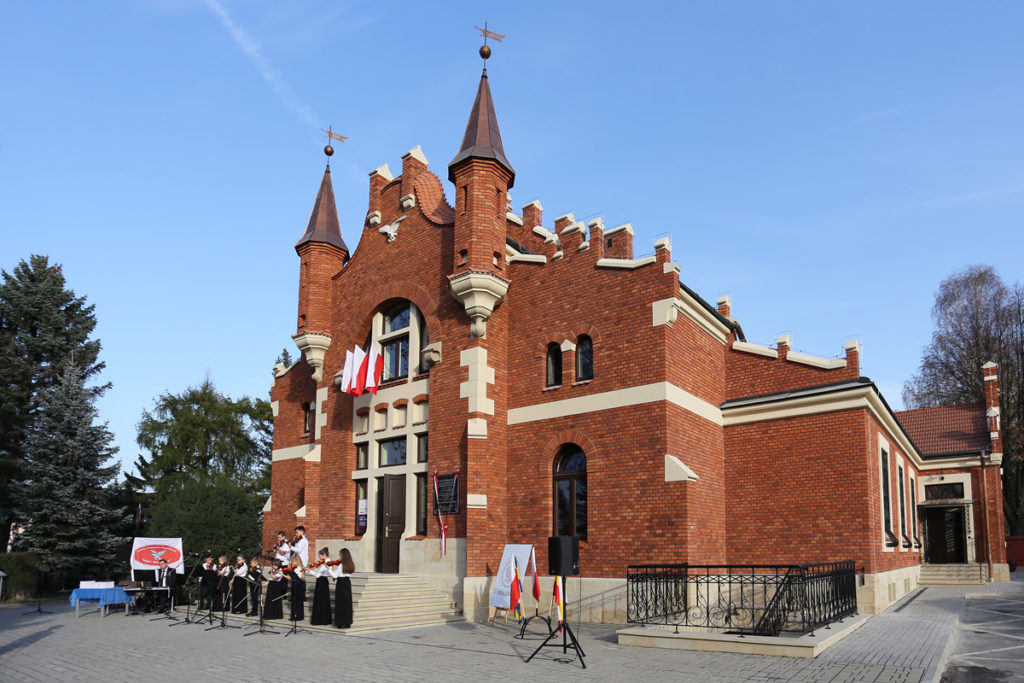
By Areta Kovalska
Sources:
1. D. Kusnierz-Krupa, Issues of revalorization of historic buildings of “Sokół” in former Galicia
2. Будівля брідського «Сокола» – забутий витвір архітектора Лаврентія Дайчака
3. The Building of the Sokół (Falcon) Gymnastic Society – Brzozów
4. Extension to the Sokół cultural center in Nowy Sącz
5. Sokół Nisko – klub, który nigdy nie latał wysoko
6. https://lia.lvivcenter.org/uk/objects/dudaieva-8-sp/
7. https://galnet.fm/zupynyt-rujnuvannya-budivli-na-remont-dahu-boryslavskoyi-dyussh-vytratyly-piv-miljona/
8. https://www.starosadeckie.info/spacerownik/spacerownik-budynek-sokola/
9. ‘Sokół’ Gymnastics Association | Municipal Cultural Center
10. Pierwsze lata jarosławskiej ,,Sokolni” (1901 – 1914)
11. Rzeszow Teatr w Gmachu Sokola
12. https://www.ck.przemysl.pl/ck/historia.html
13. wadowice.pl
14. Polona.pl
15. SOKOLNIE GALICYJSKIE – HISTORIA I STAN OBECNY
16. Коломия. Будинок польського гімнастичного товариства “Сокіл” (1895 р.)

